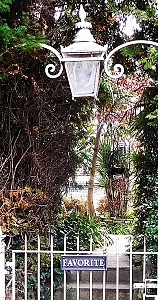Adam Yamey's Blog: YAMEY, page 137
January 26, 2022
U or non-U
January 25, 2022
Buried no longer
THE ITALIAN WRITER and patriot, Ugo Foscolo (1778-1827) was born on Zakynthos when it was part of the Venetian Republic. He became a political activist in what is now Italy and came to London in 1816. In London, he was regarded as a literary celebrity, but this did not always keep him out of trouble. For example, in about 1813 he faced Mr Graham, the editor of the “Literary Museum” in a duel at Primrose Hill. The dispute that led to this was about his ‘Three Graces’. These three ladies were sisters working in Foscolo’s home near Regents Park. Two of them turned out to be prostitutes, and one of them ran off with his former translator. This led to a duel, whether in Regent’s Park or Primrose Hill is not clear; fortunately, no blood was shed.
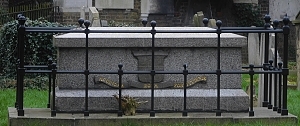 Foscolo’s monument in Chiswick
Foscolo’s monument in ChiswickFoscolo lived another few years until 1817, when he died in Turnham Green in west London. He was buried in the lovely churchyard next to the Chiswick church of St Nicholas, where the artist William Hogarth was also interred. The cemetery contains Foscolo’s elegant, well-maintained grave, which is surrounded by a cast-iron railing.
However, Foscolo’s remains are no longer in the old cemetery at Chiswick.
In June 1871, ten years after the Unification of Italy, Foscolo’s remains were dug up and transported to Florence (Firenze). There, they were reburied but within the church of Santa Croce. This is all recorded by words carved on the monument in the Old Chiswick Cemetery.
January 24, 2022
Great exhibition at Kew Gardens
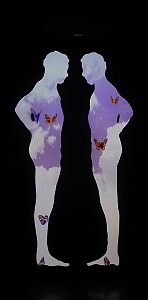
Well worth seeing: a visually and philosophically fascinating exhibition by Zadok Ben-David at Kew Gardens until 27th of March 2022. See more at:
https://www.kew.org/kew-gardens/whats-on/zadok-ben-david-natural-reserve.
The artist uses delicate models of the natural world to illustrate that life simultaneously has its dark and light aspects. This innovative exhibition has to be seen to be believed. It makes for an intriguing accompaniment to the lovely botanical gardens.
January 23, 2022
On the grass
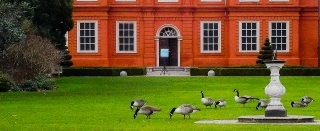 Kew Palace where King George III used to stay occasionally
Kew Palace where King George III used to stay occasionallyGeese on the lawn
Grazing keenly beneath their feet
Where a king once stood
January 22, 2022
Little green huts
SOUTH OF KENSINGTON Gardens, just west of the Royal Garden Hotel, there is a small green hut with a pitched roof beside Kensington Road. It is one of the thirteen remaining cabmen’s shelters dotted around central London, which were established by the Cabmen’s Shelter Fund (‘CSF’) in 1875 and are still maintained by this organisation. Back in those days, cab drivers could not leave a cab stand whilst they were parked there. This made it difficult for cab drivers to obtain food and drink whilst on duty.
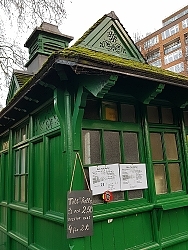
The solution to this problem was devised by the newspaper editor George Armstrong (1836–1907) and Anthony Ashley-Cooper, 7th Earl of Shaftesbury (1801-1885). They conceived the idea of the shelters to provide cabdrivers with refreshment. By law, the shelters had to be no larger a horse and cart, which explains their small size. That way, they did not encroach on the carriageway too much. In the past, these shelters confined themselves to serving cabmen. More recently, members of the public can buy snacks and drinks at these huts, whose attendants are supposed to make a living from their shelters. Cabmen can eat within a shelter, but others can only use them for take-away refreshments.
Recently, when passing the shelter on Kensington Road, I noticed that there were a couple of menus attached to it. Next to them was a small blackboard on which the following was written in chalk:
“Till Rolls 3 for 2.50 Receipt pads 4 for 2£”
This is stationery for the exclusive use of taxicab drivers. I was pleased to see this because it means that although they are open to the public, they are still of special use to cabdrivers.
I have never sampled anything at a cabmen’s shelter, so have no idea of the quality provided. Years ago, when I was practising dentistry, one of my patients was a taxicab driver. He was a ‘foodie’ and told me that he knew great quality, reasonably-priced eating places all over London. I cannot recall that amongst the many places he told me about that there were any cabmen’s shelters.
January 21, 2022
Look, no hands
WE VISITED TWO churches in Suffolk, and inside them we spotted three things that particularly interested us. The first church is in Cavendish, The Parish Church of St Mary the Virgin. Standing on a hill above the village, its construction dates from 1300 and was largely completed by 1485. Some restoration work was carried out in the 19th century. One of the two things that fascinated us in this church is affixed to the inside of the north wall. It is a bas-relief depicting the Crucifixion. It is a reredos of Flemmish make, created in the 16th century. It is framed in a Victorian surround designed by Ninian Comper (1864-1960) in 1895. The sculpted reredos was brought to the church from the private chapel of the hymn writer Athelstan Riley (1858-1945) in London, following his death.
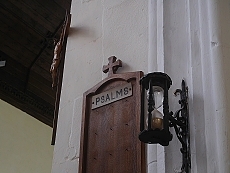 Cavendish church
Cavendish churchThe other curiosity in this church, which has memorials to the philanthropists and local parishioners Baroness Sue Ryder and Baron Leonard Cheshire, is on a wall just behind the 19th century wooden pulpit within arm’s reach of the preacher. It is an hourglass, looking like a large egg-timer, which the priest could use to time his sermon. I had never seen such a thing in a church. Less curious but also fairly unusual are the 13 wooden crucifixes on the interior walls of the bell tower. These were made from wood salvaged from the Western Front during WW1 and each one commemorates one of the men from Cavendish who were killed in the conflict.
The other church we visited on our recent trip to Suffolk was St Mary in Stoke by Nayland, which was sometimes painted by John Constable (1776-1837), who was born nearby in East Bergholt. Built in Perpendicular Gothic style between 1300 and 1481 it is very majestic, like a small cathedral. The church is full of interesting monuments including many fine brasses. It was one of the funerary monuments that particularly intrigued us: the Lady Anne Windsor monument. Anne lived from about 1568 until 1615. A stone carving depicts her lying with her head on a pillow. At her feet, there is a carving of a kneeling man, Anne’s son. By her head, two carvings depict a pair of kneeling women, Anne’s daughters. Look closely at this pair and you will notice that their hands have been broken off. Their arms are merely amputated stumps. What is going on here?
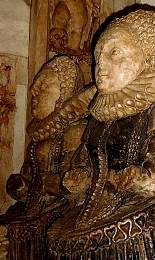 Stoke by Nayland church
Stoke by Nayland churchThe answer is that in 1643, Parliamentary Commissioners visited the church in Stoke by Nayland and destroyed 100 religious images and 7 funerary items. Part of this over-zealous iconoclastic behaviour was the removal of the four hands of the two women on Lady Anne’s monument, as well as those of the recumbent figure of the deceased. All the hands of females on the monument were removed but those of the kneeling male figure were left untouched. Apparently, the female hands were removed because the Commissioners considered them to have been in “a superstitious attitude of prayer”, whatever that meant during the Reformation.
The three items I have described are but a few of the things worth seeing in the two churches. I have chosen to describe them because I have not seen such things in the many other parish churches I have visited in England.
January 20, 2022
A doctor from China
THE CHINESE MEDICAL College in Hong Kong was founded in 1887 by the physician Sir James Cantlie (1851-1926), who was the inventor of what we now call ‘first aid’ and one of the founders of The London School of Tropical Medicine. One of his first students in Hong Kong was Sun Deming, better known as Sun Yat Sen (1866-1925). In 1878, Sun went to Honolulu to live with his elder brother. There, he was educated well in English at school. Aged 17, he returned to China. After desecrating a temple, he fled to Hong Kong, then under British rule, where he continued his education, joining the Chinese Medical College in 1887, having already studied a bit of western medicine elsewhere. In 1892, he graduated as a medical doctor. He became a friend of Sir James Cantlie.
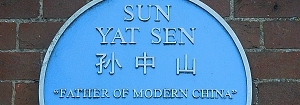
In 1896, poor health forced Cantlie to return to London. That year, Sun came to England to visit Cantlie. Already out of favour with the Imperial Chinese government because of his revolutionary activities, private agents employed by the Chinese were sent to Liverpool where he landed to follow his movements. The reason for his conversion to political activism are summarised in an on-line article (www.newstatesman.com/international-co...) as follows:
“The contrast between the colonial advancement he encountered abroad and the endemic poverty he knew from home convinced Sun that China needed revolutionary change. Rather than becoming a doctor, he helped engineer a rebellion in Canton (Guangzhou) in 1895. The failure of the uprising forced Sun to go on the run, which is why he ended up in Britain the following year.”
The first person that Sun visited after arriving in London was his old teacher Cantlie, who lived close to the Chinese embassy, which was, and still is, in Portland Place. On his way there, Sun was kidnapped and held captive in the embassy. He would have faced death had not he persuaded the embassy’s English housekeeper, a Mrs Howe, to smuggle a note to Dr Cantlie. An influential man, Cantlie managed to get Sun released, as was described in the above-mentioned article:
“In the end, it was an article about the kidnapping in the Globe that did the trick. On the following day, 23 October 1896, a large crowd formed outside the legation, noisily demanding Sun’s release. While diplomatic and legal wheels moved in the background, the ambassador and his staff realised they had to let their prisoner go. Sun emerged on to the street a national hero. While recovering at Cantlie’s house, he gave a long interview to the liberal-left Daily News, giving British readers their first insights into China’s embryonic revolutionary movement.”
Late last year, we were driving to Buntingford in Hertfordshire when we passed through the nearby village of Cottered. As the traffic was slow-moving, we managed to spot a memorial plaque attached to a house. We did not stop, but we saw enough of it to realise it had something to do with Sun Yat Sen. Very recently, we returned to Cottered to look at the plaque more carefully because we were intrigued that the Sun Yat Sen had a connection with a tiny Hertfordshire village. The plaque attached to a house called The Kennels reads as follows: “Sun Yat Sen “Father of Modern China” was a frequent visitor to this house while in exile from his home country.” Beneath Sun’s name there are three Chinese characters: “孫中山” which Google translates as ‘Sun Yat-sen’.
Curious to know more, we rang the doorbell of the house in Cottered and were greeted by a kindly gentleman, who explained that The Kennels was formerly owned by Sir James Cantlie. An article in an issue of the “The Comet”, a Hertfordshire newspaper, dated March 2017 (https://www.thecomet.net/news/sun-yat-sen-in-cottered-the-father-of-modern-china-5358282) revealed:
“His connection to the property, called The Kennels, comes from his life-long friendship with physician Sir James Cantlie, who owned the house, earlier taught him medicine in Hong Kong – and in 1896 saved him from imprisonment by agents of the Qing monarchy at the Chinese Legation in London.
Dr Sun visited the Cantlies in London and Cottered whenever he was in Britain … Sir James’ son Kenneth recalled one of the statesman’s visits to the village:
‘I must have been about five years old. It was sunset on a summer evening, and Dr Sun was walking up and down in the orchard. He was wearing a grey frock-coat and his homburg hat was tilted forward to keep the level sun out of his eyes. He had his hands behind his back and was pondering deeply. I was about to rush up to him in my usual impetuous way, when I stopped. ‘He is probably thinking great thoughts,’ I said to myself, and I went quietly away. I was not in the least afraid of Dr Sun, who was kindness itself – but my parents and my nurse may have put the idea into my head that here was a great man who must not be interrupted when he was thinking.”
Lieutenant Colonel Kenneth Cantlie (1899-1986) was about five years old in 1904, which was when Sun was living outside China.
The article continued:
“In 1912, after the success of the Xinhai Revolution – which established a Chinese republic, with Sun Yat-sen as its first provisional president – the doctor wrote with clear affection to the Cantlies. On paper headed ‘The President’s Office’, he wrote: “It makes me feel more grateful to you when from the present position I look back on my past of hardships and strenuous toil, and think of your kindnesses shown me all the while that I can never nor will forget.”
Both Sir James and his son Lt Col Kenneth are buried in the cemetery of Cottered’s parish church close to its southern door. According to “The Comet”:
“After Dr Cantlie died and was buried at St John’s Church in Cottered in 1926, the Chinese minister to Britain, Sao-Ke Alfred Sze, laid a memorial tablet at the church. Dr Cantlie’s grave in the churchyard is engraved with a Chinese translation of the gospel verse Matthew 5:7.
China Central Television visited the house in 2001, and again in 2011 as part of filming for a documentary series on the Xinhai Revolution.”
Sadly, I could find neither the tablet amongst the Cantlie family gravestones nor the engraving in Chinese, which is a translation of “Blessed are the merciful, for they will be shown mercy”. Despite this, revisiting Cottered was well worthwhile, and it has for me sparked an increased interest in the birth of modern China. We hope to return to Cottered to see inside its church, which, judging by pictures posted online, looks fascinating.
January 19, 2022
Art deco in Kensington
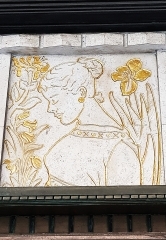
FROM THE LATE 19th century until a few years ago, High Street Kensington was a healthily flourishing retail centre. In its heyday, it boasted of three large department stores, Pontings, Barkers, and Derry & Toms. The impressive buildings that housed the latter two still stand and are fine examples of art deco architecture located close to the Underground station, which has been in service since the late 1860s. In recent years, the advent of on-line shopping, high rents, and the proximity of the Westfield Mall at Shepherds Bush (opened 2008), which has good parking, have conspired together to make High Street Kensington less appealing to shoppers. Consequently, at any one time a large proportion of shops remain empty awaiting new tenants. Sadly, what was once (especially in the 1960s and ‘70s) a bustling high street with trendy shops like Biba and the ‘funky’ Kensington Market, both gone, has become slightly dreary.
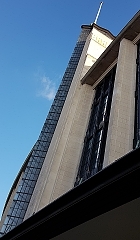 Barkers building
Barkers buildingBarker’s former shop, a lovely art deco edifice, which opened in 1933, was designed by Bernard George (1894-1964). Between 1928 and 1962, he was the chief architect for Barker’s of Kensington in-house design group. It is worth examining this building closely to enjoy is many attractive details.
January 18, 2022
Constable and the clouds
THE ARTIST JOHN Constable (1776-1837) loved Hampstead and eventually lived there. It was in that part of London, then a large village, that he became fascinated by the depiction of clouds. Here is an extract relating to this from a book about Hampstead, which I am in the process of writing:
In the last of a series lectures he gave to the Royal Institution in Albermarle Street in 1836, Constable emphasised his systematic approach to depicting nature, by saying:
“Painting is a science and should be pursued as an inquiry into the laws of nature. Why, may not landscape painting be considered a branch of natural philosophy, of which pictures are but the experiments?”
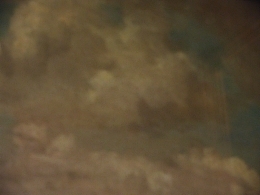 Clouds over Hampstead Heath by John Constable
Clouds over Hampstead Heath by John ConstableOne of Hampstead’s attractions for Constable was its wide expanse of sky, which, as the historian Thomas Barratt wrote, the artist:
“… regarded as the keynote of landscape art, and so assiduously did he study cloud, sky, and atmosphere in the Hampstead days that Leslie, his biographer, was able to become possessed of twenty of these special studies, each dated and described. Constable was a man of Wordsworthian simplicity of character, fond of all things rural, and devotedly attached to birds and animals.”
The website of Cambridge’s Fitzwilliam Museum reinforces what Barratt wrote:
“While living at Hampstead, Constable made a series of oil sketches of the sky alone, each one marked with the date, time and a short description of the conditions. His interest in clouds was influenced partly by the work of the scientist Luke Howard, who had in 1803 written a pioneering study, classifying different types of cloud …”
In “The Invention of Clouds” by Richard Hamblyn, a biography of the chemist and amateur meteorologist, who devised the modern classification of clouds (cumulus, nimbus, etc.), Luke Howard (1772-1864), it is noted that Constable, who was familiar with Howard’s work, focussed his concentration:
“… on the extension of his observational range and clouds were the means that he had chosen for the task. After years of searching for an isolated image, seeking a motif upon which to weigh his technical advancement as a painter, he had found it at last in the unending sequences of clouds that emerged and dissolved before his eyes like images on a photographic plate.”
During the summers of 1821 and 1822, Constable made over one hundred cloud studies on the higher ground of Hampstead and its heath. Writing in 1964 in his “The Philosophy of Modern Art”, the art critic/historian Herbert Read (1893-1968), who lived in Hampstead, commented that Constable was:
“… rather a modest craftsman, interested in the efficiency of his tools, the chemistry of his materials, the technique of his craft. His preparatory ‘sketches’ are no more romantic than a weather report. But they are accurate, they are vividly expressed, they are truthful.”
Read next contrasted Constable with Turner, pointing out that the former was far more attentive to depicting nature accurately than the latter, who became increasingly extravagant in his portrayal of it, always moving towards what is now called ‘expressionist’. Barratt wrote that although Constable admired Turner, he had no desire to imitate him and:
“He knew his limits, and recognised that within those limits were to be found subjects worthy of the highest aspirations. “I was born to paint a happier land,” he wrote, “ my own dear England ; and when I cease to love her may I, as Wordsworth says, — ‘never more hear her green leaves rustle or her torrents roar..’”
January 17, 2022
Noguchi on show in London
AT FIRST GLANCE, the lower floor exhibition space at the Barbican art gallery in London resembles the lighting department of a furniture store such as Habitat. It is full of lighting units with Japanese-style paper and bamboo shades. After a moment, you will notice that these lighting units are not run-of-the-mill illuminations; they are interestingly shaped works of art lit up from within. These lamps are part of an exhibition of the artistic creations of Isamu Noguchi (1904-1988). Born in Los Angeles, he was the son of a Japanese father and an Irish American mother. The first 13 years of his life were spent in Japan, where he began learning carpentry whilst helping his mother building their family house. From these early skills, it was not long before he embarked on what was to become a highly productive creative career, making works from a wide variety of materials from wood and stone to metals and plastics and … you name it.
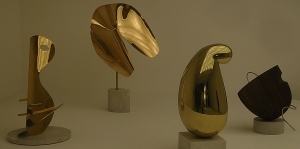
Noguchi studied sculpture at the Leonardo da Vinci Art School in New York City. In 1927, he was given a grant to travel to Paris. It was there that he was apprenticed to the Romanian-born sculptor Constantin Brâncuși (1856-1957), who introduced him to abstraction. After learning much from the great sculptor in Paris, Noguchi abandoned pure abstraction and moved towards depicting the living world. However, his experiences working with Brâncuși influenced his artistic output for the rest of his life. After Paris, Noguchi travelled extensively, learning about techniques and philosophies, especially Chinese and Japanese. In 1929, he first met the architect and inventor Richard Buckminster Fuller (1895-1983), whose ideas about science and technology chimed with his. In the exhibition, there is a shiny chrome-plated bronze bust he made of Buckminster Fuller in 1929. There are also a couple of models he created in collaboration with Buckminster Fuller. Noguchi’s interest in science was not only expressed in sculptures but also in stage settings for ballet performances choreographed by Ruth Page and for performances by Martha Graham.
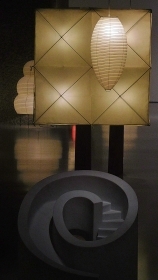
During WW2, although it was not required for him to enter one of the camps where the Americans ‘cooped up’ potential Japanese enemy aliens – Japanese who lived in the USA – Noguchi volunteered to be confined in a camp in Arizona. By doing so, his aim was to create an arts programme that would ease the lives of those confined in the camp. The barren landscape surrounding his camp proved to be yet another influence on his creative output.
Amongst the many exhibits in the Barbican’s show, there are, in addition to the lighting units, several pieces of furniture designed by Noguchi. One of these is a triangular plate glass tabletop supported by two interlocking timber supports. I have seen this elegant item for sale in upmarket furniture shops, but until I saw the exhibition, I had no idea it had been designed by Noguchi as long ago as 1944. It is still being made today. The wonderful variety of lighting sculptures, which at first reminded me of lampshades that were trendy in students’ rooms in the 1970s, are examples of ‘Akari’. Noguchi began creating them in the early 1950s, and despite their fragile nature, they are still in good condition now. One of the gallery invigilators told us that the translucent paper used to construct these lamps is made from mulberry tree bark. Known as ‘Washi’, this handmade paper can also be made from the bark of some other tree species.
As with other exhibitions at the Barbican gallery, the artworks are well-displayed and beautifully lit. If you go to this exhibition, you should not miss the video film in which Noguchi talks about his life and art very eloquently. And while you are watching it, you can sit on stools and a bench Noguchi designed. Prior to visiting this show, I had heard of Noguchi and seen a few of his works. The exhibition, which continues to the 23rd of January 2022, has truly opened my eyes to what a magnificent artist he was.

